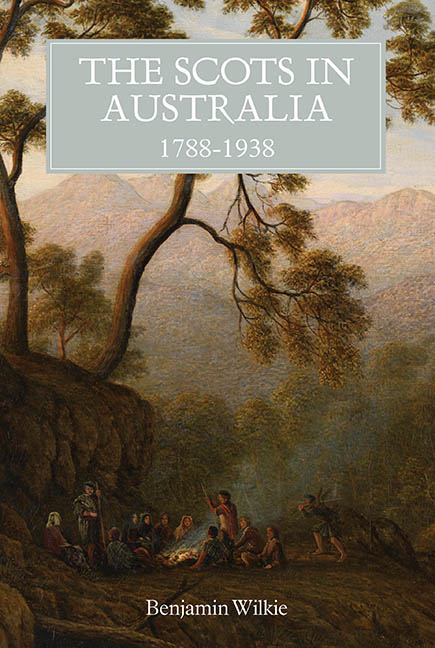Book contents
- Frontmatter
- Contents
- Illustrations
- Acknowledgements
- Abbreviations
- Introduction
- 1 From Scotland to Australia: Convicts, Free Settlers, and Encounters with Australia
- 2 Caledonia Australis: Imperial Commerce, Migrant Networks, and Australian Pastoralism
- 3 Scottish Migrants and Indigenous Australians
- 4 Imagining Home: Scottish Culture in Australia
- 5 Warriors of Empire: A Case Study of Popular Imperialism
- 6 The Empire Builders: Imperial Commerce and Migration between the Wars
- 7 New Scots: Industry, Settlement, and Working-Class Migration
- 8 At The Edge of Scotland's Diaspora: Diversity and Tension in the Twentieth Century
- Conclusion: The Imperial Legacy
- Bibliography
- Index
3 - Scottish Migrants and Indigenous Australians
Published online by Cambridge University Press: 23 August 2019
- Frontmatter
- Contents
- Illustrations
- Acknowledgements
- Abbreviations
- Introduction
- 1 From Scotland to Australia: Convicts, Free Settlers, and Encounters with Australia
- 2 Caledonia Australis: Imperial Commerce, Migrant Networks, and Australian Pastoralism
- 3 Scottish Migrants and Indigenous Australians
- 4 Imagining Home: Scottish Culture in Australia
- 5 Warriors of Empire: A Case Study of Popular Imperialism
- 6 The Empire Builders: Imperial Commerce and Migration between the Wars
- 7 New Scots: Industry, Settlement, and Working-Class Migration
- 8 At The Edge of Scotland's Diaspora: Diversity and Tension in the Twentieth Century
- Conclusion: The Imperial Legacy
- Bibliography
- Index
Summary
Looking out over Dja Dja Wurrung country from Pyramid Hill in 1835, Mitchell, seemingly unaware of the people his claims would displace, observed ‘A land so inviting, and still without inhabitants! As I stood, the first European intruder on the sublime solitude of these verdant plains … I felt conscious of being the harbinger of mighty changes; and that our steps would soon be followed by the men and the animals for which it seemed to have been prepared.’ By the late 1840s his vision had become reality, but with consequences few had predicted. Mitchell later saw that the introduction of livestock had been ‘by itself sufficient to produce the extir¬pation of the native race, by limiting their means of existence; and this must work such extensive changes in Australia as never entered into the contemplation of the local authorities’. The European colonisation of Australia seemed ‘to involve, as an inevitable result, the extirpation of the aborigines; and it may well be pleaded, in extenuation of any adverse feelings these may show towards the white men, that these consequences, although so little considered by the intruders, must be obvious to the natives, with their usual acuteness, as soon as cattle enter on their territory’.
‘Silently, but surely’, wrote Mitchell, ‘that extirpation of aborigines is going forward in grazing districts, even where protectors of aborigines have been most active; and in Van Diemen's Land, the race has been extirpated, even before that of the kangaroos, under an agency still more destructive.’ Scottish explorers such as Mitchell were at the forefront of both imperial and global European expansion, the necessary consequence of which was the removal of indigenous peoples from their land. No history of Scotland's diaspora is complete without consideration of the people the Scots – as essential and, indeed, proud partners of the British Empire – dispossessed and massacred across lands seized for the imperial project. As one Australian historian observed, the narrative of the Scots abroad and the tragic history of Aboriginal dispossession ‘do not sit well together, and yet, of course, they are connected. Though the task is challenging and difficult, it is worth consid¬ering both Scottish diaspora and Indigenous histories together, for when we do, we can better understand some of the complexities of empire and colonisation in the nineteenth century.’
- Type
- Chapter
- Information
- The Scots in Australia, 1788–1938 , pp. 51 - 72Publisher: Boydell & BrewerPrint publication year: 2017



